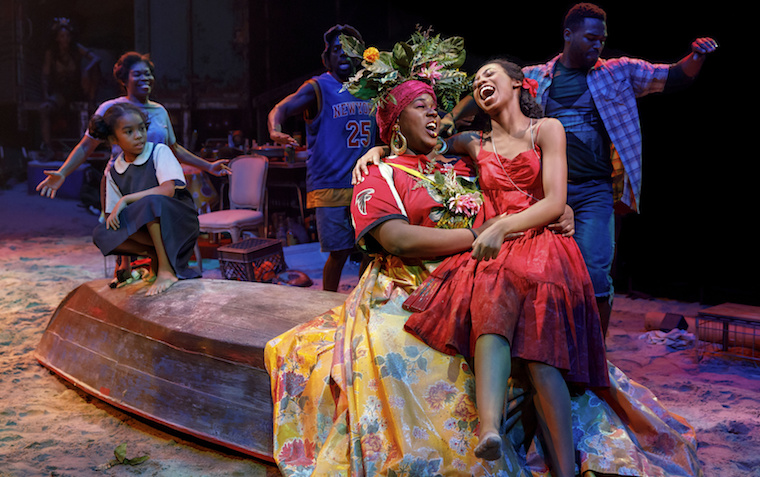Circle in the Square Theatre
Inventive, ingenious and invitingly-entertaining, ‘Once on This Island’ has transformed the Circle in the Square into a piece of theatrical paradise. Set on “an island in the French Antilles, then and now,” the current revival magically places its audience right on the island as well (and front row ticket-holders would do well to dress accordingly, i.e. for sand, which I neglected to mention to my Mom as she carefully strode across the beach in open-toed fancy shoes). It’s a delightful rendering of immersion theater that never feels gimmicky or trite, one that succeeds largely because the music and emotion behind the story are strong enough to merit a revival.
‘Once on This Island’ tells the tale of a little girl who loses her family in a storm but is taken in by a loving set of parents. When she grows up, she falls in love with a man she helped nurse back to health, but is prevented from being with him by their economic and social status. The interplay of nature versus society runs throughout the show, and the gorgeous melodies and songs of Stephen Flaherty and Lynn Ahrens (the team that would later create the equally-beautiful music of ‘Ragtime’) anchor the spectacular visuals.
Enchanting and epic, the breezes that blow off this magnificent musical are based on the most primal emotion of them all: love. It is felt in the details of the piece, from the present moment magic of the maelstrom to the distant evocation of the gods. It’s there in the sand beneath our feet and the water lapping at the edge of the stage. It’s there in the computer cords making up the headdress of one goddess, the plastic bags hanging like a couture necklace around another, and the Coca Cola spines of the deliverer of death. At once immediate and timeless, the musical sings the song of familial loyalty, endless love, sacrifice, loss, and redemption.
Hailey Kilgore is a revelation in her star-making turn as the grown Ti Moune. Her journey from wide-eyed innocent to cast-out lover helps turn this production into a seering work of art; her final scene at the gate is the heartbreaking stuff of theatrical legend. Isaac Powell gives a compelling performance as Daniel, object of and willing participant in Ti Moune’s affection. Daniel makes his own choices, as much as he is allowed, realizing his own trapped fate and powerless (or unwilling) to fight against it. It’s a difficult role, less showy and emotionally brittle as Kilgore’s, and more tricky because of it. That we are just as torn by his fate is testament to Powell’s complex portrayal (and I’m not just saying that because he complimented my shoes before the show began).
As the couple who takes in Ti Moune, Philip Boykin and Kenita R. Miller provide support, ambivalence, warnings and love as they let their little girl go. More than that, Ms. Miller offers a devastating portrayal of a mother-figure faced with the prospect of losing her child, something she shows in tears or the worrying of her hands as she sprinkles sand in superstitious protection. Her more powerful spell comes in the form of love, such as when she joins her daughter in a dance to show the society snobs a moment of unabashed revelry and joy.
The various gods supply both plotline catalysts and a sort of Greek chorus sounding board. Quentin Earl Darrington makes a commanding Agwe, overseeing the sea and the storms with whimsical and sometimes fierce abandon. Broadway veteran Lea Salonga brings her glorious soprano presence to the island as Erzulie, spinning choral gold with words of love. She is but one voice of many that raises this production to the realm of greatness.
The staging is genius, and it’s not just about the beach. I never thought anything more could be done with the sand on stage, but when it dissolves into a glorious carpet, and then into a floor of marble, it’s like a miracle happening right before your eyes. Such stagecraft is stunning, lending more wonder to the enchantment at hand, yet it remains rooted to the reality of the present, as it’s not a special effect but a clever manipulation of materials on hand. A car chase finds abstract assembly of its main vehicle in surprisingly effective form, while the gates of the palace are as formidable as they are fluid. Performers make double and sometimes triple duty use of the wreckage on-set; repeated viewings are probably necessary to fully appreciate all the little details as well as the majestic way they work together to create a perfect panoply.
The music remains the centerpiece here, and though there are some individual songs that stand out, it’s the piece as a whole that wields its true energy and power, even and especially in the aftermath of devastation and loss. The lilting and bittersweet ‘Some Girls’ is as heartrending as ‘We Dance’ is uplifting. Instruments are made from discarded plastic bottles and similar flotsam, resulting in a raw, organic sound – all the better to appreciate the voices.
By the final act of rebirth, storytelling has become a faith and religion unto itself. We pass on traditions, and songs, and tales of our past so that the future generations may learn, live and love better than those of us who came before. The last notes are hopeful reminders that the past, no matter how painful, can be reconstructed and repurposed – much like the throw-away objects that form the costumes and scenery here – and reborn in a new way. Without telling that story, there would be nowhere to go.


